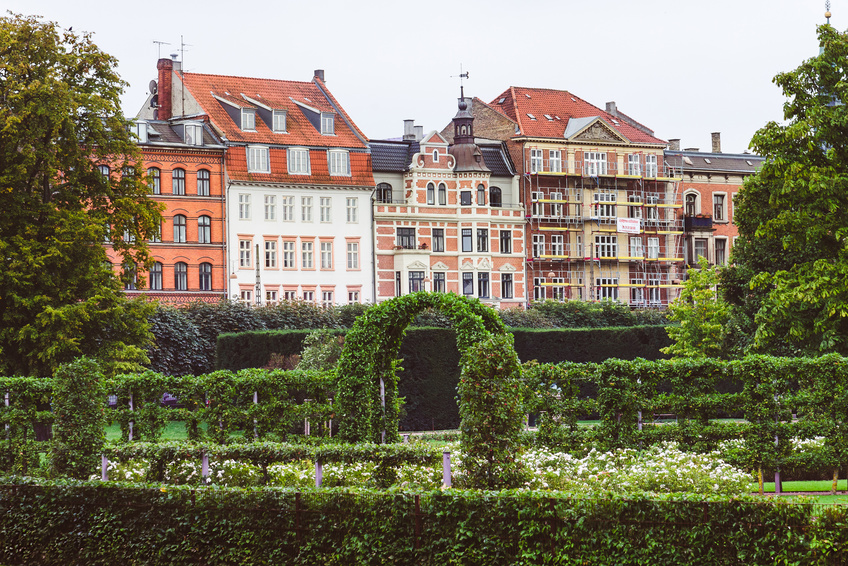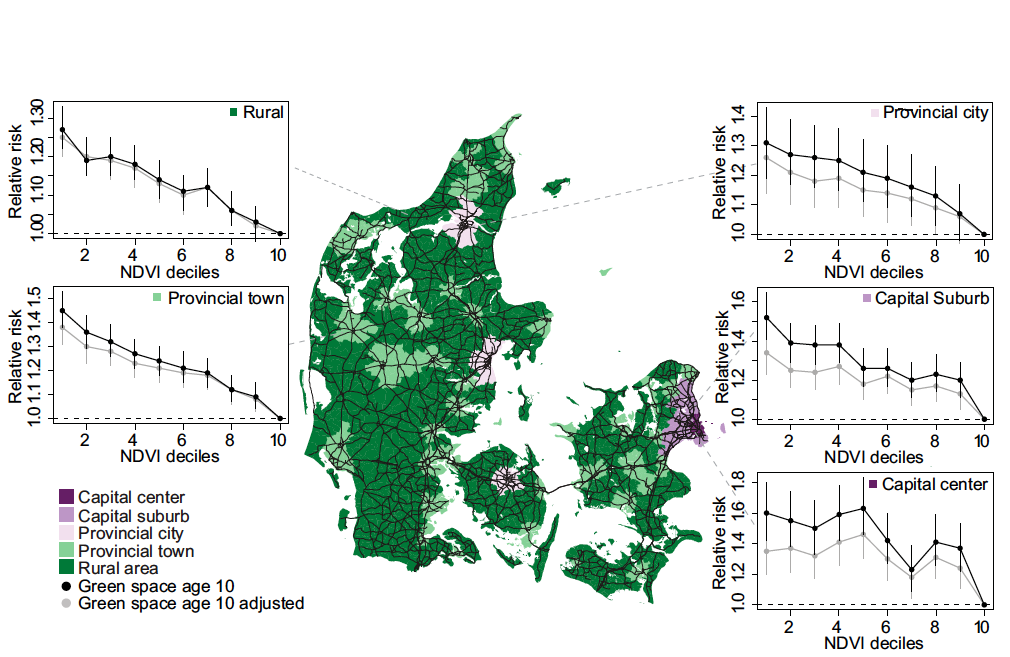
In a sweeping nationwide study, researchers from the University of Aarhus in Denmark have found that childhood exposure to green space reduces the relative risk for developing an array of psychiatric disorders during adolescence and adulthood.
This study could have far-reaching implications for healthy city design, in effect making green space-focused urban planning an early intervention tool for reducing mental health problems.
Using the historic Landsat archive and the extensive geolocated Danish Civil Registration System, the residential green space of nearly a million Danes was tracked for a decade and correlated with mental health outcomes—making this the largest epidemiological study to document a positive connection between green space and mental health.
Researchers found that those living with the least green space had as much as a 55% increased risk of developing a spectrum of psychiatric disorders such as depression, anxiety, and substance abuse. When the data were adjusted for other known risk factors including a family history of mental health disorders, parental age, and socioeconomic status the relationship held for all psychiatric disorders expect intellectual disability and schizoaffective disorder.
The impact of green space throughout childhood is momentous: green space exposure is comparable to family history and parental age when predicting mental health outcomes, only socioeconomic status was a slightly stronger indicator.
Researchers are still working out why green space is so beneficial. It can encourage exercise, provide spaces for socializing, decrease noise pollution and air pollution, and improve immune function by providing exposure to beneficial microbiota. It can also help with psychological restoration, providing a respite for over-stimulated minds.
It has been established that city living can increase the risk for some psychiatric disorders. While the specific mechanism behind this increased risk is unknown, those dwelling in cities have higher neural activity which is linked to higher stress levels. Today, with over half of the global population residing in cities and that number growing, health professionals are looking for ways to reduce the increased risk of psychiatric disorders that city living can cause.
Green space offers risk reduction
Green space provides health benefits across the population and the effect is dose-dependent, meaning those who have longer exposures to residential green space have greater mental health benefits.
While urban areas stand to benefit most from increasing green space, this protective association is not just for urbanites. The study found that longer exposure to green space was linked to bigger risk reductions from the city center to rural outskirts, and no upper limit to the benefit was found.

Researchers found that longer exposure to green space was linked to bigger risk reductions of developing psychiatric disorders no matter the location—from the city center to rural outskirts, and no upper limit to the benefit was found. Image credit: Engemann, et al., 2019
Green space most strongly protects against mood disorders, depressive disorder, neurotic behavior, and stress-related issues, the study found, signaling that psychological restoration may be the strongest protective mechanism green space offers.
Logistics of this landmark longitudinal study
This research, published in the Proceedings of the National Academy of Sciences, followed over 940,000 Danish citizens born between 1985 and 2003 from birth to age 10. Researchers tracked the amount of green space around each citizen’s residence (by giving a greenness score to a 210-square meter zone around each home).
Two rich and extensive data sources made this research possible: the Danish register which contains georeferenced addresses, health records, and socioeconomic data for citizens reaching back into the 1960s and the long, global archive of 30-meter Landsat data.
Lead author, Dr. Kristine Engemann from the Department of Bioscience at Aarhus University in Denmark, explained, “We decided to use Landsat data because it was free, high-resolution (compared to MODIS for example), and covered Denmark back to 1985.”
She said that the time aspect was especially important for the study because the information on green space had to match the temporal range of the register, reaching back in time as long as possible so that a large number of people could be included in the study—the study was able to follow roughly a sixth of the entire Danish population.
To find the presence of vegetation around individuals’ homes, Engemann used Landsat to calculate the Normalized Difference Vegetation Index (NDVI), a ratio of near infrared and red reflectance. NDVI exploits the reflective properties of vegetation by comparing measurements of near infrared (which plants reflect strongly) with red (which plants largely absorb) reflectance—making NDVI a proper proxy for green space.
“As a researcher with a limited budget, using the Landsat data for free made this project possible,” Engemann said. “The global geographic range together with free availability ensures that our study could potentially be repeated in other countries.”
Building evidence for building with green space
This study adds to the growing body of evidence that green space is integral to human health and that exposure to natural environments is beneficial for maintaining good mental health.
Green space provides mental health benefits while simultaneously protecting all of the good things that the natural environment provides, like filtered water, oxygen, and biodiversity. Urban planning that prioritizes the integration of green space—especially in neighborhoods where children live and places where children spend considerable time like schools—can be considered a preventative measure that contributes to better mental health.
Based on this research, green space should be a planning priority. As Engemann advises, “Finding ways to provide high green space exposure during childhood should be encouraged by parents as well as in sustainable urban planning.”
Reference:
Engemann, Kristine, Carsten Bøcker Pedersen, Lars Arge, Constantinos Tsirogiannis, Preben Bo Mortensen, and Jens-Christian Svenning. 2019. “Residential green space in childhood is associated with lower risk of psychiatric disorders from adolescence into adulthood.”Proceedings of the National Academy of Sciences116 (11):5188. doi: 10.1073/pnas.1807504116.
Related reading:
+ Study finds access to nature in childhood helps mental health
+ Green and privileged childhoods signal better adult mental health
+ Greener Childhood Associated With Happier Adulthood
+ Green Space & Health: U.S. Counties with More Trees and Shrubs Spend Less on Healthcare
+ Rethinking the future of cities: How trees are revolutionizing cities around the world, UN FAO
Science feature written by Laura E.P. Rocchio, NASA Landsat Communication and Public Engagement team






